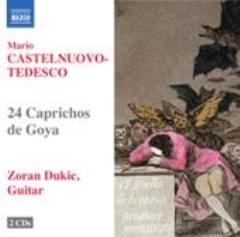Castelnuovo Tedesco - 24 Caprichos de Goya Op. 195 (2009)
Castelnuovo Tedesco - 24 Caprichos de Goya Op. 195 (2009)

Disc 1 1. No. 1. Francisco Goya y Lucientes, Pintor (Francisco Goya y Lucientes, Painter) 00:03:50 2. No. 2. Tal para qual (Two of a kind) 00:03:57 3. No. 3. Nadie se conoce (Nobody knows oneself) 00:02:02 4. No. 4. Ni asi la distingue (Even so he cannot make her out) 00:01:54 5. No. 5. Muchachos al avio (The boys getting ready) 00:02:37 6. No. 6. El amor y la muerte (Love and death) 00:03:57 7. No. 7. Estan calientes (They are hot) 00:02:04 8. No. 8. Dios la perdone: Y era su madre (God forgive her: and it was her mother) 00:03:40 9. No. 9. Bien tirada esta (It is nicely stretched) 00:02:59 10. No. 10. Al Conde Palatino (To the Count Palatine) 00:02:51 11. No. 11. Y se le quema la casa (And he's burning down the house) 00:02:45 12. No. 12. No hubo remedio (Nothing could be done about it) 00:06:28 Disc 2 1. No. 13. Quien mas rendido? (Which of them is more overwhelmed?) 00:02:34 2. No. 14. Porque fue sensible (Because she was sensitive) 00:04:12 3. No. 15. Si sabra mas el discipulo? (Perhaps the pupil knows better?) 00:03:42 4. No. 16. Brabisimo! (Bravissimo!) 00:02:50 5. No. 17. De que mal morira? (Of what ill will he die?) 00:04:56 6. No. 18. El sueno de la razon produce monstruos (The sleep of reason produces monsters) 00:05:15 7. No. 19. Hilan delgado (They spin finely) 00:03:24 8. No. 20. Obsequio a el maestro (Gift to the master) 00:03:43 9. No. 21. Que pico de oro! (What a golden beak!) 00:02:31 10. No. 22. Volaverunt (Off they flew) 00:01:47 11. No. 23. Linda maestra! (Pretty teacher!) 00:03:03 12. No. 24. Sueno de la mentira y inconstancia (Dream of lying and inconstancy) 00:05:27 Zoran Dukic - guitar
With its grotesque cast of supernatural beings and subhuman characters, the satirical etchings of Francisco Goya’s Los Caprichos (1799) portray the sufferings of 18th century Spain in some of Western art’s most influential images. Originally conceived for Andrés Segovia, Mario Castelnuovo-Tedesco’s 24 Caprichos de Goya has seldom been recorded complete, as it is here by Croatian guitarist Zoran Dukic, whose spectacular virtuosity, profound musicianship and artistic maturity have won him more first prizes in international competitions than anyone else in the world. ---naxos.com
Mario Castelnuovo-Tedesco's set of 24 Caprichos of Goya is among the most important large-scale cycles of guitar music of the twentieth century. Castelnuovo-Tedesco had been a significant composer in the history of the instrument since meeting Andrés Segovia in Venice in 1932. Castelnuovo-Tedesco, an Italian-Jew who left his native country in 1939 in response to the Mussolini government's racial laws of that year and settled in the United States, was inspired by the association of the instrument with Spain to write a number of works with Spanish flavor.
Like most of his music since his self-imposed exile from Italy, Castelnuovo-Tedesco's Caprichos de Goya is tonal and melodic. There is a flirtation with twelve-tone technique in the 15th Caprice, but this has evident satiric intentions, which is fitting, because the whole cycle is based on a satirical work of art. (In this Capricho a tone row is stated in its base form, then in retrograde inversion, but after this by-the-numbers serialism, the music wanders away into the realms of tonality.)
The 24 Caprichos de Goya are representative of a major trend in the later part of his life, which was composing works that explored the relationships between music and other arts. Just the year earlier Castelnuovo-Tedesco had composed another set of 24 pieces for guitar, Platero y Yo (Platero and I), based on the poetry of Spanish writer Juan Ramon Jiménez. It uses a speaker to read the selections from Jiménez' book that pertained to each piece. The composer's purpose was clearly to make the audience aware of the extra-musical impulse behind each number played, for he said in cases where the audience already knew the original poem, the narrator could be omitted.
Following the success of Platero y Yo, Castelnuovo-Tedesco undertook this set of guitar works, again with Andrés Segovia in mind as its soloist. It was intended to be premiered as a recording project, rather than in concert. The entire work takes an hour and a quarter to perform.
The stimulus for the music is a collection of etchings, 80 in all, by the great Spanish painter Francisco Goya y Lucientes. They are monochrome prints, and border on caricature. Their usual subject is the frivolity of social and amorous relationships, with sudden sharp excursions into the tragedies of life. Castelnuovo-Tedesco's music is primarily in dance music forms, even in the etchings that are in darker mood, such as "Love and Death," where the embrace of the two is depicted with the feeling of a tango in its rhythms.
The composer organized his settings so as to begin and end with the painter. The opening movement is based on Goya's self-portrait, in which he shows himself as something of a vain dandy, and uses a musical motive based on Goya's name. The final movement depicts the love affair between Goya and the Duchess of Alba. Since this etching features mirror images, this final movement is in the form of a mirror fugue, in which the "Goya" motive returns. ---Joseph Stevenson, Rovi
download (mp3 @128 kbs):
yandex 4shared mega mediafire zalivalka cloudmailru uplea ge.tt
Zmieniony (Poniedziałek, 08 Sierpień 2016 17:07)
